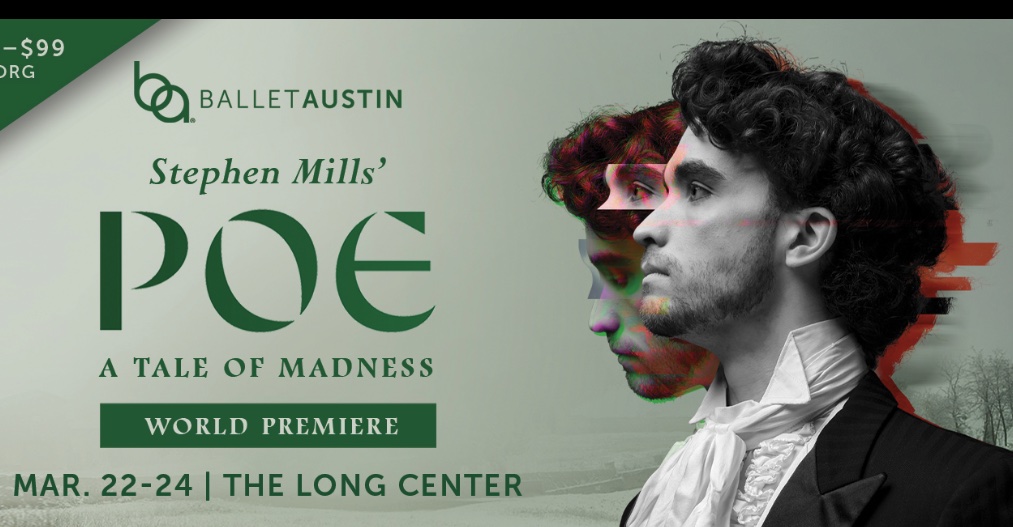Review: POE / A Tale of Madness by Ballet Austin
by David Glen Robinson
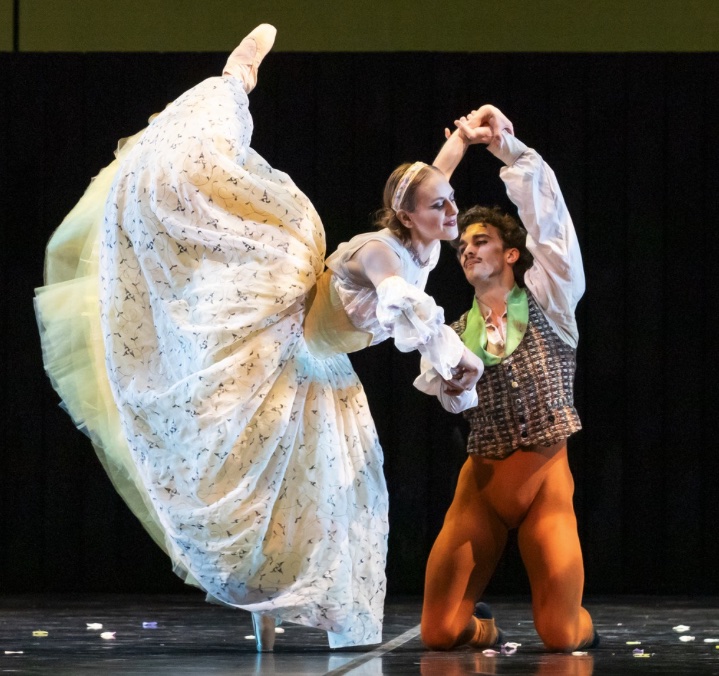 Such a cliché, visually stunning. But how necessary to convey an overall introduction to Poe / A Tale of Madness by Ballet Austin and Stephen Mills. Yes, visually stunning along with artistically, emotionally, intellectually, and esthetically stunning. Afterward, it was only to sit in the comfortable Dell Hall seat with private thoughts, feelings, and joy, waiting uncaringly for the noisy downtown Austin world to reclaim one’s senses. The ballet was one of the few fine arts experiences that truly can be called fulfilling.
Such a cliché, visually stunning. But how necessary to convey an overall introduction to Poe / A Tale of Madness by Ballet Austin and Stephen Mills. Yes, visually stunning along with artistically, emotionally, intellectually, and esthetically stunning. Afterward, it was only to sit in the comfortable Dell Hall seat with private thoughts, feelings, and joy, waiting uncaringly for the noisy downtown Austin world to reclaim one’s senses. The ballet was one of the few fine arts experiences that truly can be called fulfilling.
Poe / A Tale of Madness is a powerful multi-media work of art, a characterization usually reserved for operam which also blends theatre, music, and visual arts. The truth is that for a few years now in the 21st century, ballet has emerged as the one hybridizing multimedia form integrating all other arts with open arms (and en pointe). Ballet Austin, led by the immeasurably gifted and supported by philanthropic saints, is at the forefront of the modern arts’ proud stride into the future. Change is not coming, it has arrived.
The ballet had its world premiere March 22-24, 2024, in the Dell Hall of the Long Center. Stephen Mills was the primary creative force of the ballet, choreographer of the dance and director of Sarah and Ernest New Choreography Endowment. The Butlers also commissioned POE through the endowment. Major co-creators of the show, besides the permanent staff of Ballet Austin, included the Austin Symphony Orchestra, Peter Bay conductor, directing commissioned music by Graham Reynolds. Shawn Sides of Austin’s Rude Mechs performance group wrote the libretto. Internationally recognized Michael B. Raiford designed the set, and Margaret Mitchell accomplished the herculean task of costume design. Credit for lighting design was shared by Tony Tucci and Erin Earle Fleming. Wendy Sanders styled the hair and theatrical makeup of the performers.
The blending of all the ingredients on stage gave us period props and set, all goth-inflected; colorful costumes of whimsy and dark-toned vampiric threat; a sweeping fluorescent pendulum (“The Pit and the Pendulum”); a hospital ward of upright beds flying in and out; a dyed fabric cloud of despair to envelope Poe; graves of the not-dead; and monumental graphic raven feathers to unite all the elements of the production. The story, to quote the program, “takes place inside Poe’s mind during his last hours before death.” This deep interior setting allowed Mills and the ballet to touch lightly on Poe’s stories, mixed images flashing as in fevered dreams. The character of Poe was danced by Paul Martin and Morgan Stillman in alternation.
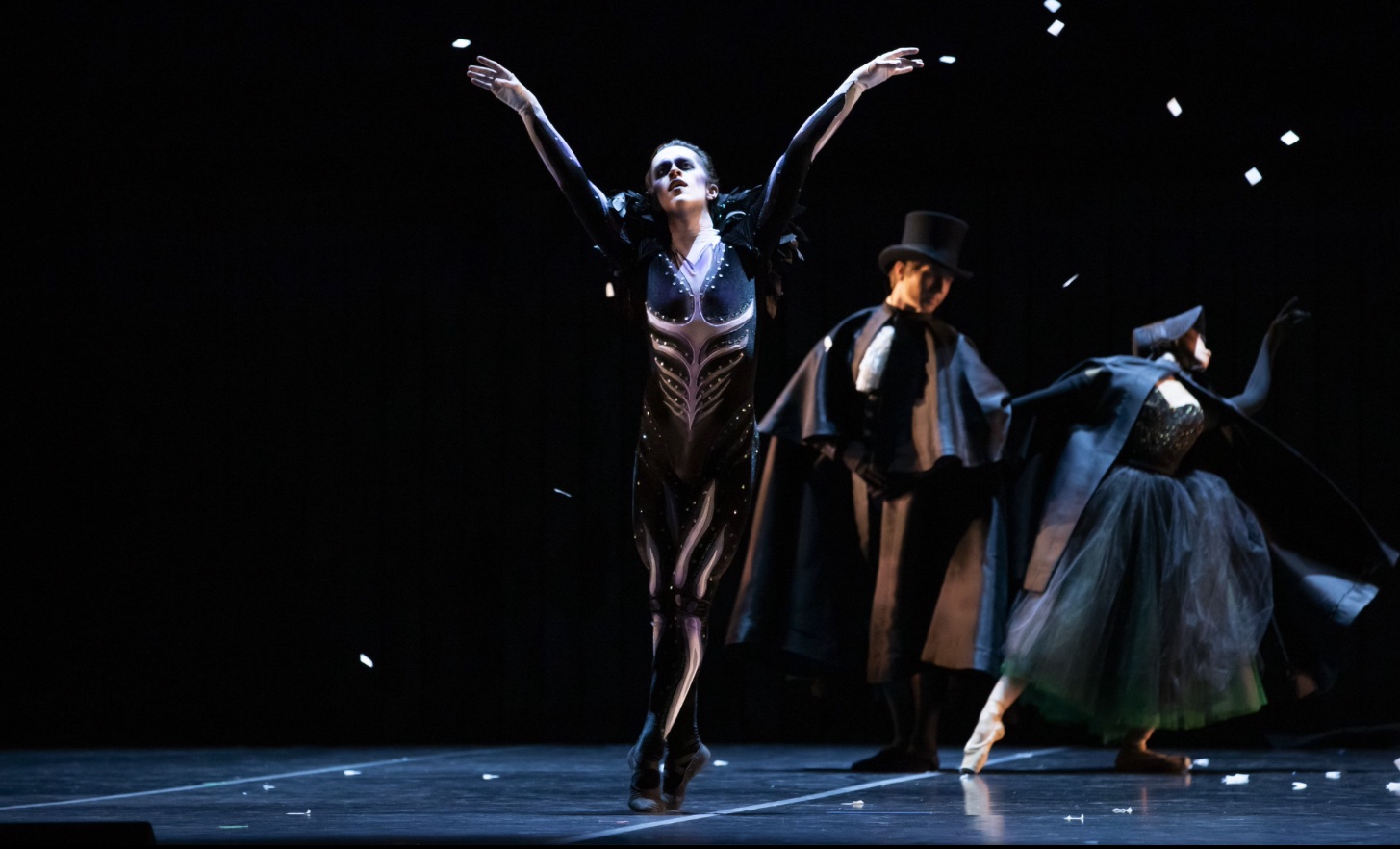
Who is Edgar Allan Poe without a raven? Ian J. Bethany personified the bird and symbol of arch horror lurking atmospherically in all of Poe’s horror stories. Performing at the peak of his game, possibly, Bethany danced in black skeletal tights and black feather epaulets elongated and exaggerated to evoke raven’s wings. His performance in movement was sheer easy and smooth perfection, so that one can easily believe a human can fly unaided. Move over Mary Martin of now ancient Peter Pan. The raven’s lengthy perches on Poe’s desk conveyed the character of the Raven, brooding, morose, and posed in stillness and foreboding. We can readily believe the Raven atop the bust of Pallas shall leave its perch nevermore.
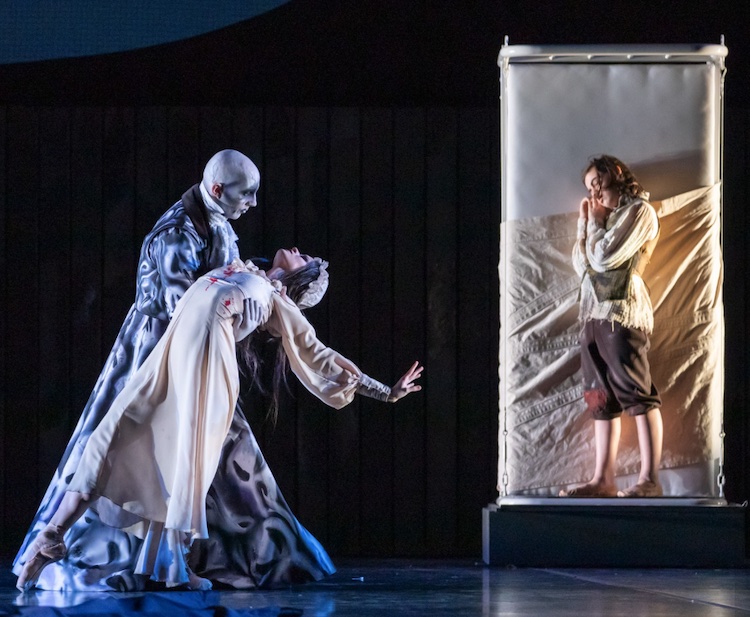
The Imp of the Perverse was also double cast, with James Fuller and Colin Canavan. The character is described as Poe’s doppelganger or alter ego. The Imp frees Poe to convey prostrate depression while the Imp enacts flashback dancing scenes from Poe’s life with his family and loves. Poe and the Imp also dance together in groups in additional flashbacks. Other double cast roles are Mother (Katherine Deuitch and Grace Morton) and Sissy (Grace Morton and Katherine Deuitch). This group of flexible and step-perfect dancers are indeed primos and primas, well and aptly described as such. They are definitely “firsts” in any ballet company. Vivien Farrell as Madeline, Leighton Taylor as Roderick, and Celena Fornell as Nurse performed equally well in their smaller but no less important roles
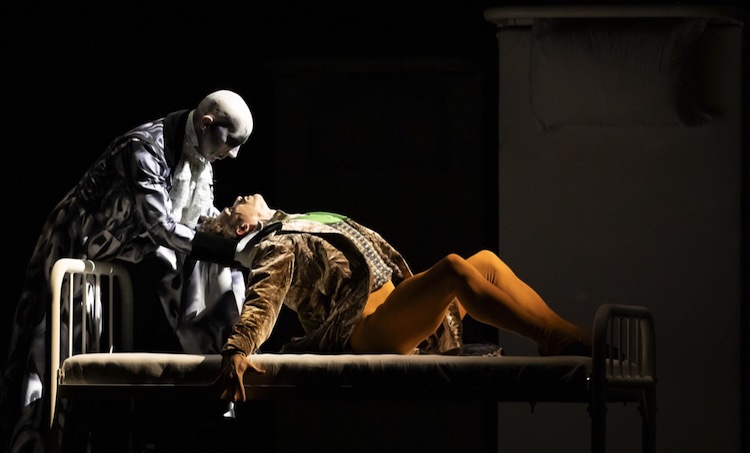
Of course, Death, so prominent in Poe’s short life, was embodied by a dancer. The role was played, better yet inhabited, by Edward Carr, mastering a schizoid, almost dual role. Extremely tall, not quite spindly, and with sepulchral visage, Carr was the superb casting choice of the show. The first refraction of his death character was the overarching thanatic Lord, appearing for all sooner or later—sooner for all the women in Poe’s life. Death danced with groups and only gradually focused on his subject. The second refraction was as the Red Death, who with slight styling changes danced in Mills’ evocation of Poe’s “The Masque of the Red Death.” That story has always been poised for ballet treatment, and Carr/Death danced through it as a leader in the masqued ball, again later taking away one of the women in Poe’s life. Unlike the ravening beast of plague in the short story, who played all-fall-dead as he stalked through the rooms of the ball, Carr’s Death danced marvelously in caped gothic magnificence, and also gently with an air of compassion as he exited with his charge. This subtly gentle tone recalled a half-remembered poem about how the Death Angel unseen is the God of Fear. When the angel approaches, it is angry. And when it arrives, it is beautiful.
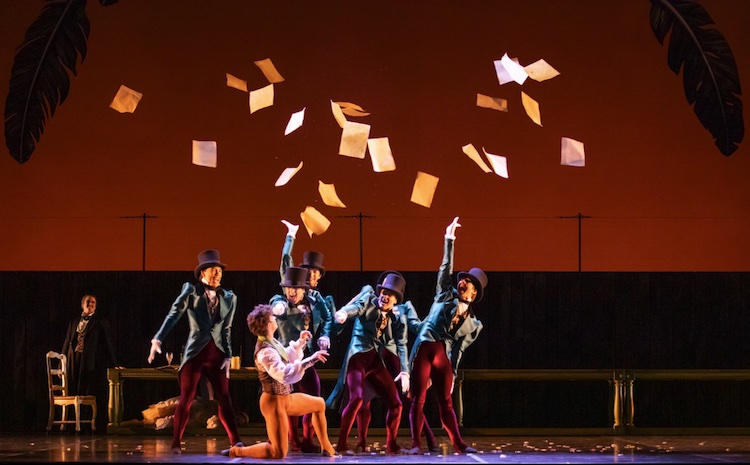 The corps de ballet had important work to do as well. A favorite large ensemble scene involved the literati, the New York editors, critics, and intellectuals who came in as a crowd, wrecked Poe’s home and rejected and tore up the manuscript of his finest work— “The Raven.” Talk about a tale of madness. This segment is one of great tongue-in-cheek irony: the literati are depicted as toads. Their movement involved a lot of uncoordinated hopping, jostling, and asymmetry. They were costumed in shiny beetle-back green waistcoats over bright red velvet tights, topped off with the nineteenth-century top hats of the intelligentsia. The unspoken commentary is apt today. The choreography of the literati/toads is one of those quiet, almost secret niche treasures, matched recently only by the uncredited Dance of the Wolves in last summer’s musical theatre Disney’s Beauty and the Beast at Bee Caves, suburban Austin.
The corps de ballet had important work to do as well. A favorite large ensemble scene involved the literati, the New York editors, critics, and intellectuals who came in as a crowd, wrecked Poe’s home and rejected and tore up the manuscript of his finest work— “The Raven.” Talk about a tale of madness. This segment is one of great tongue-in-cheek irony: the literati are depicted as toads. Their movement involved a lot of uncoordinated hopping, jostling, and asymmetry. They were costumed in shiny beetle-back green waistcoats over bright red velvet tights, topped off with the nineteenth-century top hats of the intelligentsia. The unspoken commentary is apt today. The choreography of the literati/toads is one of those quiet, almost secret niche treasures, matched recently only by the uncredited Dance of the Wolves in last summer’s musical theatre Disney’s Beauty and the Beast at Bee Caves, suburban Austin.
The corps danced in three other sections, without flaw on the afternoon this reviewer attended. Their names are too many to cram into a review of this scope, but they are well reported in the program online. They are excellent; their opportunities to become “firsts” are surely coming to them.
One section of exceptional merit stood out. Poe crouched at center stage and four characters—Death, Raven, Imp, and Roderick—entered holding the four corners of an enormous sheet of fabric, rectangular and perhaps forty feet long, dyed to depict clouds,. They danced the billowing clouds of despair that enveloped and beset Poe in his later life. The dance was largely walking in patterns to create billowing shapes while Poe created his own shapes in desperation in floorwork. The fabric arched over him, covered him, tied him around, and sourced the figurative rain of misery he could never escape. The painted cloud-forming fabric garnered credits for Lourdes Yesenia Tafur de Grancharoff as the painter/dyer, and Christine Joly de Lotbiniere as the fabric printer.
Mills’ choreography was committedly in service to the characters and story. His choreographic esthetic was apt for all the characters, singularly so in the case of the Raven. Choreography and movement for the Literati may be unique in modern ballet, conjoined brilliantly with Margaret Mitchell’s costumes. Kudos to all.
EXTRA
Video Promo
POE / A Tale of Madness
by Stephen Mills, after Edgar Allan Poe
Ballet Austin
March 22 - March 24, 2024
MARCH 22-24, 2024 | THE LONG CENTER, Austin
Tickets $19 - $99, available now! https://bit.ly/POE2324
Ballet Austin tel. 512 476-2163
